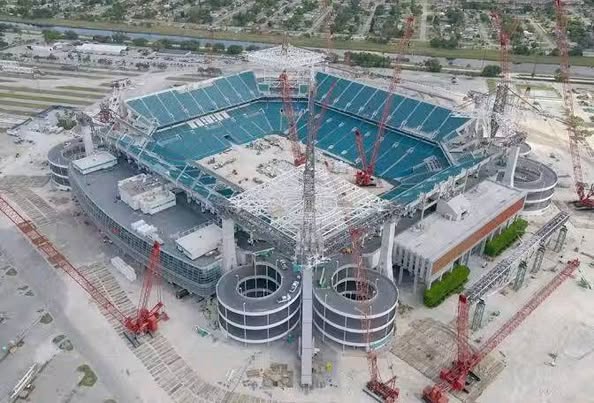In a move set to revolutionize the college football landscape, the University of Miami and its athletic department unveiled today a $5.3 billion renovation plan for Hard Rock Stadium that redefines the standards for collegiate athletic facilities nationwide. The comprehensive renovation—described as the most ambitious project in college football history—not only cements Miami’s position as a top-tier football program but also elevates the fan experience to a level typically reserved for the NFL and international mega-events.
From smart seats to luxury sky villas, retractable playing surfaces to augmented reality zones, the upgraded Hard Rock Stadium is not just a venue—it’s a spectacle.
A Vision Years in the Making
The concept for this massive overhaul began several years ago as Miami’s leadership sought to ensure the Hurricanes football program stayed competitive in the ever-evolving world of college athletics. While the program boasts a rich legacy, including five national championships and generations of NFL-caliber talent, it lacked the modern-day infrastructure now critical in recruiting and brand visibility.
“We realized that in order to compete with the best of the best, we couldn’t just match—we had to lead,” said Miami Athletic Director Dan Radakovich during Tuesday’s press conference. “This stadium project is a statement to every recruit, every fan, and every opponent: the Miami Hurricanes are committed to excellence at every level.”
The project is backed by a mix of private investments, university funds, partnerships with local government entities, and major corporate sponsorships, including new naming rights extensions with major tech and luxury lifestyle brands.
Unprecedented Features: The Future Is Here
What sets this renovation apart is not just the price tag, but the innovation. Hard Rock Stadium will become the first college football stadium to incorporate smart stadium AI infrastructure in its entirety. Here’s what fans and players can expect:
1. Expanded Seating and Immersive Layout
The new renovation increases the total seating capacity from 65,000 to 82,000, making it one of the largest college football stadiums in the country. Yet rather than simply add seats, the design reimagines sightlines, acoustics, and crowd dynamics. Every section is now optimized for comfort and sound intensity.
A lower-bowl redesign brings fans closer to the action, while an upper-deck sky ring—nicknamed “The Storm Halo”—offers panoramic views of both the field and the Miami skyline, complete with open-air cocktail lounges and vertical LED display columns.
2. Luxury and Hospitality Like Never Before
The stadium now includes 240 new luxury suites, including 20 ultra-premium “sky villas,” each equipped with personal chefs, butler service, private elevators, and balcony hot tubs overlooking the field. These suites will set a new benchmark in college sports hospitality, rivaling those of professional teams in the NFL or even European soccer giants.
Additionally, a high-end resort-style “Beach Club” zone behind the west end zone allows fans to enjoy poolside views of the game, complete with in-water seating and personal cabanas.
3. Cutting-Edge Technology Integration
At the core of the $5.3 billion investment is next-generation technology that pushes the boundaries of what fans can expect from a live sporting event:
- Smart Seating: Each seat comes equipped with touch panels for food orders, instant replays, stat tracking, and even multi-angle camera views of the game in real-time.
- AR and VR Integration: With in-stadium AR goggles (available via rental or purchase), fans can view player stats as they run routes, access instant positional breakdowns, or watch historic Miami highlights overlayed on live action.
- 5G Ultra-Wideband and Wi-Fi 7: Ensuring blazing-fast connectivity for all fans, enabling seamless streaming, social sharing, and digital engagement.
- Biometric Entry and Digital Concierge: Fans can use facial recognition or fingerprint scanning to enter the stadium and order food, merchandise, or request assistance from digital concierges.
4. Retractable Turf and Convertible Venue Design
One of the most stunning innovations is the stadium’s retractable playing surface, which allows it to seamlessly convert between natural grass and turf fields for different events. This means Hard Rock can host not only Miami football but also international soccer matches, concerts, Super Bowls, and more—without compromising playing conditions.
“This is a stadium built for the next 50 years,” said lead architect Javier Román of Elevation Group, the firm behind the redesign. “It’s adaptable, sustainable, and immersive. We wanted it to be more than a stadium. We wanted it to be a destination.”
5. Environmental and Sustainable Innovation
With climate change and sustainability on the forefront, the stadium also boasts a net-zero energy design, with 12,000 solar panels on its new roof structure, rainwater collection systems, and on-site food composting. The entire renovation is expected to achieve LEED Platinum certification, the highest sustainability rating available.
Miami’s commitment to the environment also extends to community programs that will stem from the project, including investments in local parks, youth athletic programs, and public transportation enhancements around the stadium site.
A New Era for Recruiting
While fans are thrilled, perhaps no one is more excited than head coach Mario Cristobal and his staff. The recruiting implications of this project are enormous.
“The facilities arms race in college football has hit a new level,” Cristobal said. “But we’re not just keeping pace—we’re setting the pace. When a recruit walks into this stadium, sees our locker rooms, our recovery centers, our AI analytics rooms—it becomes clear. This is where the future of football is being built.”
Included in the renovations is a state-of-the-art athlete performance center located inside the stadium complex, featuring cryogenic recovery chambers, VR-based training modules, and smart gym equipment that tracks player metrics in real time. The new locker rooms boast spa-like features, hydrotherapy pools, and customized player pods.
The Fan Reaction
For lifelong Hurricanes fans, the reaction has been one of awe and pride. Alums and locals flooded social media with praise for the university’s ambition and vision.
“This is what The U is all about—swagger, style, and staying ahead,” said former Hurricanes linebacker and NFL Pro Bowler Jonathan Vilma. “This stadium is going to blow people’s minds.”
Season ticket demand has already surged, with Miami reporting a 75% increase in pre-orders for 2026, when the full renovation is scheduled to be completed. Naming rights for several premium zones have already been sold to major brands including Tesla, Apple Vision, and Fendi.
Economic Impact for South Florida
City officials lauded the renovation for its economic ripple effects. It’s estimated the project will create more than 22,000 jobs during the construction phase and generate billions in long-term tourism and event revenue. South Florida is now poised to become one of the global hubs for major sporting events.
“This is a win not just for the University of Miami, but for the entire region,” said Miami-Dade Mayor Daniella Levine Cava. “From job creation to global exposure, this stadium will serve as a magnet for world-class events and elevate South Florida’s status as a premier sports destination.”
What’s Next?
Construction on the stadium’s major features begins in early summer 2025 and is expected to continue in phases until full completion in time for the 2026 college football season. The Hurricanes will continue to play at Hard Rock Stadium during renovations, with minimal disruption planned thanks to modular construction scheduling and off-season heavy work windows.
Already, the 2026 College Football Playoff semifinal game has been tentatively awarded to the new-look stadium, and Miami is bidding for hosting rights to the 2030 national championship.



